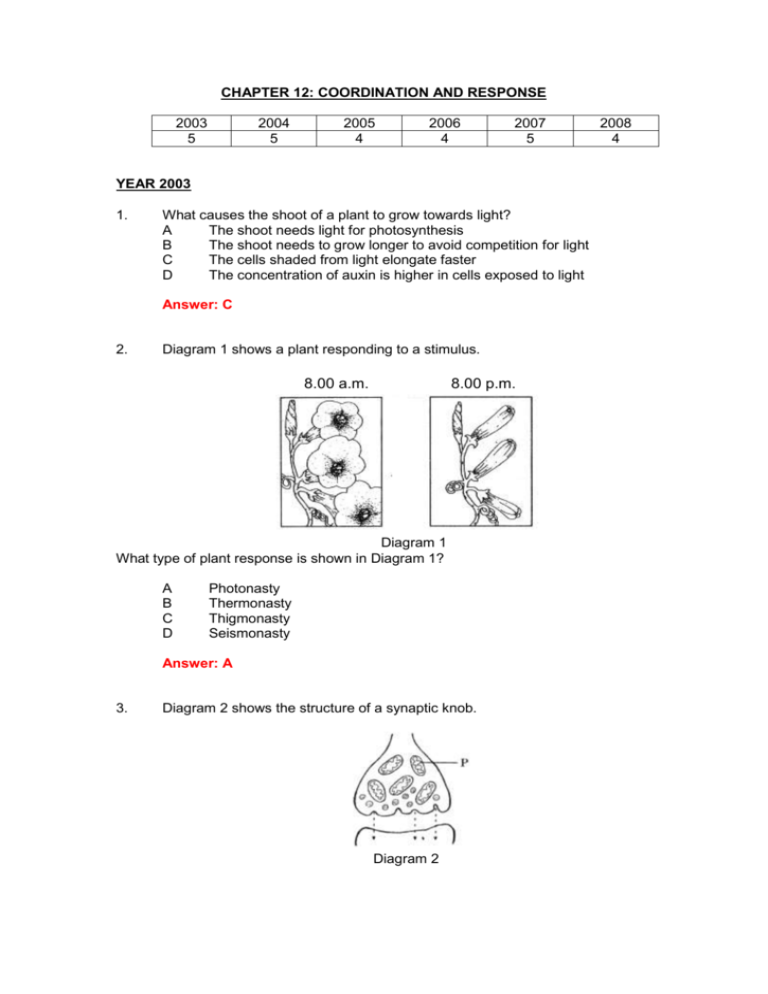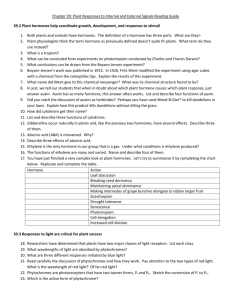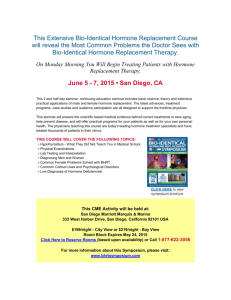TEST 6 - F5 C3 - Biology Form 5 Tests
advertisement

CHAPTER 12: COORDINATION AND RESPONSE 2003 5 2004 5 2005 4 2006 4 2007 5 YEAR 2003 1. What causes the shoot of a plant to grow towards light? A The shoot needs light for photosynthesis B The shoot needs to grow longer to avoid competition for light C The cells shaded from light elongate faster D The concentration of auxin is higher in cells exposed to light Answer: C 2. Diagram 1 shows a plant responding to a stimulus. 8.00 a.m. 8.00 p.m. Diagram 1 What type of plant response is shown in Diagram 1? A B C D Photonasty Thermonasty Thigmonasty Seismonasty Answer: A 3. Diagram 2 shows the structure of a synaptic knob. Diagram 2 2008 4 What are the structure P and its function? A Structure Mitochondrion B C D Mitochondrion Vesicle Vesicle Function Generates energy to transmit impulses across synapse Transfers impulses to cell body Secretes neurotransmitter Transfers impulses to synaptic knob Answer: A 4. Diagram 3 shows the pathway of an impulse in a reflex arc. Diagram 3 Which statement is true in Figure 3? A B C D J receives an impulse direct from L and carries it to N L transmits the impulse to M from the central nervous system The rate of impulse transmission through K increases N causes the finger to react Answer: D 5. Diagram 4 shows the structure of a nephron. Diagram 4 Which of the following activities cause X to be more permeable to water? P - Drinking a lot of water Q - Eating salty foods R - Not exercising S - Playing sports A B C D P and R P and S Q and R Q and S Answer: D YEAR 2004 1. Which of the following is a characteristic of a reflex action? A Response is controlled by hormones B Response is fast C Response is initiated under the control of the brain D Nerve impulse takes a longer path Answer: B 2. Which of the following neurones transmits the impulse from the receptor to the central nervous system? A B D C Answer: D 3. The graph shows the effect of different concentrations of auxin on the growth responses of shoots and roots. Which of the following statements explains the graph? A Concentration of auxin does not effect the growth of shoots and roots B Only a high concentration of auxin stimulates the growth of shoots and roots C A low concentration of auxin stimulates the growth of shoots whereas a high concentration of auxin stimulates the growth of roots D A low concentration of auxin stimulates the growth of roots whereas a high concentration of auxin stimulates the growth of shoots Answer: D 4. Ali was born normal but suffers from dwarfism since childhood. The suitable hormone to treat him is A B C D sex hormone gonadotropic hormone growth hormone adrenocorticotropic hormone Answer: C 5. An experiment was carried out to investigate the effect of auxin on the phototropic response of maize coleoptiles. Which of the following coleoptiles A, B, C or D will bend towards light after two days? A B C D Answer: B YEAR 2005 1. The diagram 1 shows parts of the human brain. Diagram 1 Which of the following pairs of part of brain and its function is correct? A B C D Part of brain P Q R S Answer: B Function Controls peristalsis movement Controls balancing of balancing Controls thinking Controls rate of heart beat 2. What is the function of the axon of a sensory neuron? A. B. C. D. To release neurotransmitter in the synaptic cleft. To carry impulse away from the cell body To speed up the conduction of impulse To carry impulse towards the cell body Answer: B A child runs fast when chased by a fierce dog 3. Which of the following reactions occur in the child’s body? I. II. III. IV. A. B. C. D. Blood glucose level increase Metabolic rate increase Body temperature decrease Rate of heart beat increase I and II III and IV I, II and IV II, III and IV Answer: C 4. Diagram below shows the response of a maize coleoptile to auxin in an experiment. Another experiment produces a response as shown in Figure 2 Which of the following treatment will produce the response as shown in Figure 2? Answer: A YEAR 2006 1. . Answer: A 2. Diagram 2 shows a synapse at the nerve ending. Diagram 2 What is substance P? A. Acetylcholine B. Oxytocin C. Adrenaline D. Prolactin Answer: A 3. A farmer wants to sell bananas from his farm. To ensure that all the bananas ripen at the same time, the farmer should spray the bananas with A. ethylene hormone B. auxin hormone C. gibberelin hormone D. cytokinin hormone Answer: A 4. Diagram 3 shows a method of producing fruits from flowering plants using auxin hormone Diagram 3 How is the fruit produced by this method different from the fruit produced naturally? A. The fruit is sweeter B. The fruit is more succulent C. The fruit has more fibre D. The fruit does not have seed Answer: D YEAR 2007 1. Which of the following plant hormones stimulates fruits to ripen? A. B. C. D. Abscisic acid Cytokinin Ethylene Gibberellin Answer: C 2. Diagram 1 is a graph which shows the effect of the concentration of auxin on the growth of the shoot tip and the root tip. Diagram 1 If the concentration of the auxin is in the range of 10 to 1 part per million, what is the effect on the growth of the cells of the shoot tip and the cells of the root tip? A. B. C. D. Answer: A Cells of the shoot tip Stimulate the growth of cells Inhibits the growth of cells Stimulates the growth of cells Inhibits the growth of cells Cells of the root tip Inhibits the growth of cells Stimulates the growth of cells Stimulates the growth of cells Inhibits the growth of cells 3. Diagram 2 shows the functions of hormones P and Q in regulating the glucose blood level. Hormone P Glucose Glycogen Hormone Q Diagram 2 What are hormone P and hormone Q? A. B. C. D. Hormone P Thyroxine Glucagon Insulin Adrenaline Hormone Q Insulin Thyroxine Glucagon Androsterone Answer: C 4. Diagram 3 shows a seedling placed horizontally to study its growth response. Rajah 3 menunjukkan satu anak benih diletakkan secara mengufuk untuk mengkaji gerakbalas pertumbuhan. Diagram 3 Which of the following shows the correct response? Antara yang berikut, yang manakah menunjukkan gerakbalas yang betul? Answer: D 5. Diagram 4 shows the human endocrine system. Rajah 4 menunjukkan sistem endokrin manusia. Diagram 4 Which of the glands A, B, C or D, is involved when an individual faces a moment of panic? Antara kelenjar A, B, C dan D, yang manakah terlibat semasa seseorang individu menghadapi situasi yang cemas? Answer: C YEAR 2008 1. Which of the following are involuntary actions? I Riding a bicycle II Heart beat III Winking eye IV Peristalsis A. B. C. D. I and II I and III II and IV III and IV Answer: C 2. A patient with kidney failure uses a haemodialysis machine to eliminate urea from his blood. Which statement explains the situation? A. Concentration of urea in the blood and in the dialysis fluid is the same B. Concentration of water molecules in the blood is higher than in the dialysis fluid C. Concentration of urea in the dialysis fluid is higher than in the blood D. Concentration of urea in the blood is higher than in the dialysis fluid Answer: D 3. Diagram 3 shows a traditional practice in some Malaysian households to speed up the ripening of chiku fruits. Diagram 3 What is the purpose of keeping the chiku in the rice container? A. B. C. D. To trap heat To trap ethylene To soften the fruit To trap carbon dioxide Answer: B 4. Diagram 4 shows a germinating seed. Diagram 4 Which of the following shows the condition of germinating seed after 2 days? Answer: B CHAPTER 12: COORDINATION AND RESPONSE 2004 Section A B C (1) 2005 Section A B C - 2006 Section A B C (1) 2007 Section A B (1) 2008 Section A B (1) YEAR 2004 Section B 1. (a) Figure 7(a) shows a reflex arc and Figure 7(b) shows the regulating of glucose in the blood. Both figure illustrate coordination systems in the human body. (i) Describe the reflex action in Figure 7(a) [4 marks] Sample Answer: When the finger is pricked with a needle, the receptors at the tip of the finger will be stimulated and sends impulses to the spinal cord through an afferent neurone. (1) The impulse is forced to move in one direction through synapse to the interneuron, (1) efferent neurone and to the effector. (1) The impulses causes the biceps muscle to contracts (1) and automatically withdraws the finger away from the needle. (ii) Compare the coordination system shown in Figure 7(a) and 7(b) [6 marks] Similarities: Both the coordination system respond to a stimulus (1) and involve the transfer of impulse from the receptor to the effector. (1) Differences: Figure 7(a) is a reflex action whereas Figure 7(b) is an involuntary action. (1) Reflex action cannot be controlled by brain while involuntary action can be controlled by medulla oblongata (1) Reflex action reacts towards external stimulation while involuntary action reacts towards internal stimulation. (1) Reaction and movement of reflex action are very quick and not long lasting while reaction and movement of involuntary action are slow and last longer. (1) (b) Figure 7(c) shows the organs and glands involve in regulating the human body temperature. A student skates on the ice skating rink. Based on the Figure 7(c), explain how regulation of the student’s body temperature occurs. [10 marks] Sample Answer: The stimulation of the low surrounding, internal and external temperature which is received by thermoreceptors (1) in the skin at certain parts in the brain is sent through afferent nerve to hypothalamus. (1) When the condition is cold, the smooth muscle in the arteriole of the skin will contract. (1) The diameter of the arteriole will decrease and causes less blood flows to the skin. This causes less loss of heat. (1) The erector muscle of the hair follicle contracts (1) causing the hair follicle to stand. For mammals with thick hair, this will increase the air trapped which acts as heat insulator. (1) The muscular skeleton contracts and relaxes (1) causing one to shiver. This increases the body temperature. (1) The sweat gland is not stimulated. (1) Hence, sweating does not occur. The adrenaline hormones are secreted to increase the rate of glycogen conversion to glucose, (1) hence the metabolic rate increases. YEAR 2006 Section A 3. Diagram 3.1 shows a cross section of part of the nervous system. (a) (i) Name structure X. Spinal cord [1 mark] (ii) State the function of X Control reflex action / send impulse to the brain [1 mark] (b)(i) Why is Y swollen at the dorsal root? The place where the cell bodies of sensory neurones are located [1 mark] (ii) Complete Diagram 3.1 with the neurons involved in a reflex action. Mark the direction of the impulse movement on the neurons.[2 marks] (c) Compare two structures of a sensory neurone an a motor neurone. 1. Sensory neurone has long dendron and short axon while motor neurone has short dendron and long axon. (1) 2. The cell body of sensory neurone is located outside the spinal cord while the cell body of the motor neurone is located inside the spinal cord. (1) 3. Sensory neurone begins with a receptor while motor neurone ends with an effector (1) Note: Any two comparisons [2 marks] (d) If the spinal nerve is cut off at Z, what is the effect on the organ which is connected to it? An individual is able to receive the stimulus but unable to respond. (1) The impulse able to flow to spinal cord from the receptor / brain but cannot flow to to the effector (1) [2 marks] (e) Ali’s finger accidentally touches a flame. Explain briefly how his reflex action functions to avoid injury. The receptor at the finger detects the heat and release the impulse. (1) The impulse is sent to the spinal cord through the sensory neurone. (1) Motor neurone send the impulse to the effector which then contracts and jerks the hand. (1) [3 marks] YEAR 2007 Section B 7. (b) (i) Auxin is a plant hormone which helps in plant growth. Diagram 7.2 shows the growth of a plant shoot towards light. Diagram 7.2 Explain the role of auxin in the growth of the plant shoot as shown in Diagram 7.2. Tip of plant shoot bends towards light because auxin is produced at the shoot tip. (1) More auxin accumulate at the region with lower light intensity. (1) Auxin diffused to the elongation region. (1) Auxin stimulates the cell elongation at the shoot tip. (1) [4 marks] (ii) State two commercial values of auxin in agriculture. As rooting hormones for the growth of adventitious root (1) As weed killer (1) To produce parthenocarpic fruit (1) Any two [2 marks] YEAR 2008 Section A 5. Diagram 5 shows the role of the pituitary gland as a ‘master gland’. Hormone Y is responsible for the development of a follicle in the ovary. (a) (i) Name hormone X. Thyroid Stimulating Hormone [1 mark] (ii) State the function of hormone X. Stimulate the production of thyroxine hormone [1 mark] (b) Hormone Y stimulate the development of a Graafian follicle in the ovary and sperm in the testis. Name hormone Y. Follicle stimulating hormone [1 mark] (c) The presence of hormone Y causes the secretion of hormone Z. Hormone Z affects the development of the uterus. (i) Name hormone Z. Oestrogen [1 mark] (ii) State the role of hormone Z in the development of the uterus. Stimulates the development of the endometrium wall [1 mark] (d) (i) Name hormone P. Growth hormone [1 mark] (ii) Explain how hormone P is responsible for the physical appearance of individual Q in Diagram 5. Under production of growth hormone (1) resulting in dwarfism (1) [2 marks] (e) (i) State the circumstances in which more ADH is secreted, as shown in Diagram 5. High blood osmotic pressure / blood too concentrated [1 mark] (ii) Explain the role of ADH in producing less and concentrated urine. Collecting duct and distal convoluted tubule become more permeable to water, (1) hence more water is reabsorbed into blood stream. (1) [2 marks] (f) Give one reason why pituitary gland is considered as the ‘master gland’. It controls the activity of the other endocrine glands. [1 mark]







